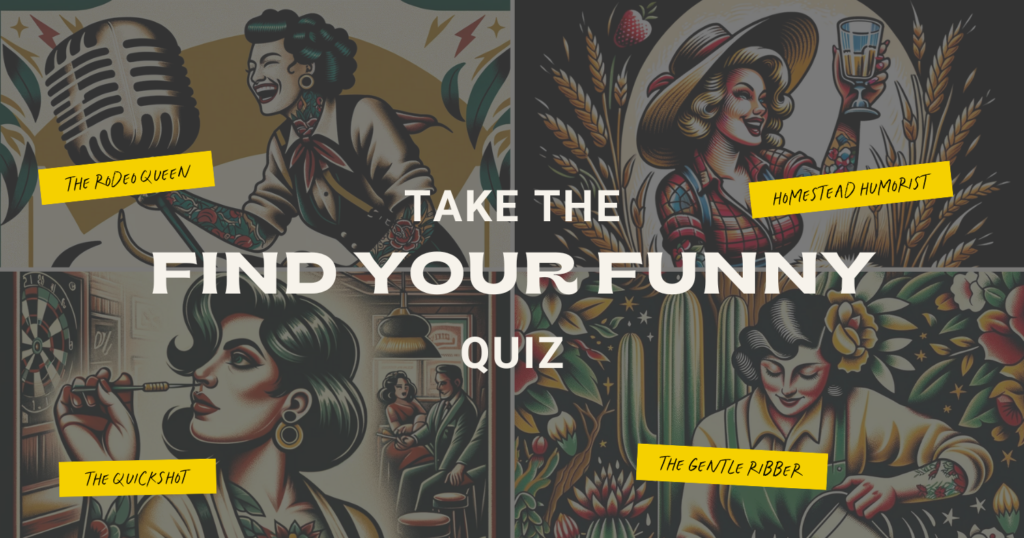
Attention is the new currency and everyone’s fightin’ for a slice with forced, spicy “hot takes” and jabbing controversial POVs.
Humor is crazy underused, which is WILD because humor builds connections, breaks down barriers, and makes your content “sticky!”
I’m not here to turn you into a comedic brand.
In fact humor ≠ comedy at all, but we can learn a lot from those who have “gone pro” – including a comedic technique called “Callbacks.”
More commonly used in stand-up or improv, comedians will circle back to a joke from earlier in the night. That’s a callback – a clever way to create a lil inside joke between themselves and the audience.
We all love the inclusion of a callback, and we can replicate this effect in copywriting.
You bring back a piece of humor from earlier in your content and BOOM! You’ve got a callback that makes your audience chuckle and feel “in the know.”
(Ya see how it’s not so much about the laughs and more about connection?)
Try one of these on for size when you craft a callback:
1) A Subtle Nod
These are brief, often understated references to earlier content. They’re like a wink to those in the know, without disrupting the flow for those who might have missed the first reference.
Great for our Quickshot and Gentle Ribber Humor Types!
If you wrote an email and mentioned your fear of being tickled, you could – in a completely different context – make a passing comment along the lines of, “Like tackling a new project, buuuuut less scary than being tickled.”
It’s a subtle nod to your earlier joke, sorta rewarding those who remember it! But without confusing others.
2) A Direct Echo
These are explicit and clear repeats of a joke, phrase, or idea from earlier. Ya can’t miss ‘em and they’re often used for emphasis. Or to simply create a strong tie-back to an earlier point.
If you’re a Rodeo Queen, this’ll come suuuuper natural to you.
Suppose you make a comment about your road rage in a social media post and tie in your offer about time management. You could directly echo your road rage issue quirk.
“Let’s get to these tips faster than I honk at a green light… you know how I feel about slow drivers.”
This directly calls back to your earlier comment, creating a laugh for those who remember.
3) A Thematic Link
These callbacks tie in broader themes or stories from previous copy. They’re perfect for narrative-style content where the callback adds depth and continuity to the overall story.
I see a lot of my Homestead Humorists NAIL this one.
Say you write a blog post with a story about when you learned to write a motorcycle. You go into it all – the fear, the excitement, the THRILL! And later, when you start talking about overcoming creative blocks, you reference the whole story.
“It felt a bit like my first motorcycle ride: intimidating at first, but thrilling once I hit my stride. Just took me understanding how to embrace the challenge and enjoy the ride.”
Regardless of how you lean into your callback, using your Brand Voice (text formatting, on-brand keywords, etc.) will drive home the delivery.
Any Humor Type can make any of these work.
So far, I know a lot of this is conceptual and I’m a big “SHOW ME HOW TO DO IT, THOUGH” gal. Let’s consider how you can implement for your own brand and marketing – go as deep as you’d like.
(That’s what she said)
→ Update a past article or blog post that’s performing well. You can integrate a callback to a more recent piece of content, or a popular topic discussed recently. It’ll refresh your older content AND create a seamless link between your pieces – increasing engagement & time spent on your site.
→ When running a podcast, reference a point made by a previous guest. It’ll add depth to the conversation and encourage your listeners to check out a previous episode. Clever, right?
→ For your next mastermind or coaching call, consider taking killer notes so you can callback to previous points made by students. You’re engaging your audience, making folks feel heard, and emphasizing the original point for continuity and cohesion.
→ Next time you launch an offer with email marketing, map out your funnel or email series in advance. Think of it like a giant story line so you can bring back characters/stories/plots in subsequent emails. Instead of blasting folks with random sales pitches, you’re creating anticipation for the next email and even click backs to your previous sales content.
→ Consider content planning your social media around themes, or create a series. I have a monthly Humor Horoscope, for instance. Each post can stand alone, but it becomes part of a larger, engaged narrative.
Rule for thee (and ye, I guess)
You know I’m anti “clear > clever,” but DO NOT sacrifice clarify for a laugh.
If your callback does not strengthen your message, drop it.
That’s it. That’s the rule.
Callbacks are about making your brand’s voice one that folks wanna hear on repeat.
Think creating Apple-level brand disciples. (Guilty)
When done right, it’ll make your content be seen AND remembered.
To understand your brand’s unique humor type, take my Find Your Funny Quiz. Everyone is funny – just in our own ways.
This quiz will give you an understanding of yours and what that means for your brand.
